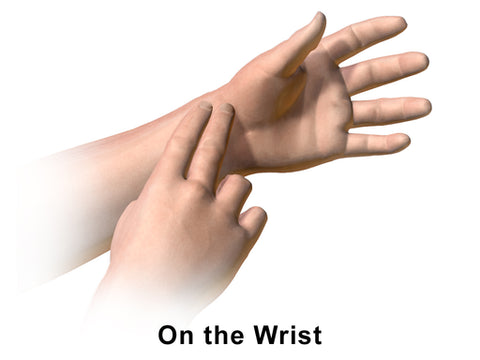The Heart Rate is the number which tells you how many times per minute your heart beats. Because there are so many things that can impact your heart rate it changes constantly throughout the day depending on what you’re doing. If you’re exercising your heart rate will increase whereas if you are relaxing your heart will be lower and this is called your resting heart rate.
The most accurate time to take your resting heart rate is when you’ve been sitting for a while. One of the easiest ways to do this is use two fingers (usually your forefinger and middle finger but not your thumb as its own pulse will confuse your readings) and gently compress the artery in your wrist or neck.

Count the number of pulses over a 15 second period and multiply this by four. Taking your heart rate in this way uses pressure whereas most wearable heart rate trackers like smartwatches use a method called photoplethysmography (try saying that quickly 3 times over…or even once!). This is an optical method of detecting the heart rate. Heart rate monitor apps for phones and tablets use the camera and light to detect the pulse. In our next article Ben, Curiscope’s Co-Founder and creator of the Virtuali-Tee, will talk a bit more about how this works and why we decided to include our own Heart Rate Tracker in the Virtuali-Tee.
Using photoplethysmography in devices such as smartwatches does have its limitations as ambient light and muscle movements can interrupt the tracker. While they might not as accurate as something like an ECG (Electrocardiogram) which involves sensors being attached to the skin that detect the electric signals produced each time your heart beats. However, devices using photoplethysmography are a quick and accessible way to take your heart rate and is particularly useful to demonstrate different heart rates.
Exercise and physical activity have a huge impact on your heart rate and regular exercise can lower your resting heart dramatically. For example, as a fairly active person my own resting heart rate tends to be in the region of 50-55 bpm and when I’m exercising my heart can reach up to 190 bpm in what is called my ‘peak heart rate zone’.

Your peak heart rate zone is the high-intensity exercise zone. You can calculate your peak heart rate with the traditional formula of 220 minus your age. When your heart rate hits this zone it means it is over 85% of your maximum heart rate. You’ll experience your heart rate hitting this if you’ve ever cycled up a steep hill for more than a few minutes or if you’ve been doing intense exercise for an extended period of time.
Professional athletes tend to have resting heart rates that typically dip below 40. Mo Farah’s resting heart has been recorded at 33 bpm! Athletes usually have these lower heart rates due to something called stroke volume, which means the volume of blood that the heart is capable of pumping out with each stroke. This is because the muscles in the heart are much stronger, just like you’ll see with your other muscles after long-term training. The higher the volume of blood pumped per stroke the lower your heart rate, which creates a higher level of efficiency for professional athletes who are expending huge amounts of energy. This is what also reduces your resting heart rate as you can build up your stroke volume over time. For a normal person who doesn’t run a marathon in just over two hours, they don’t need a high stroke volume.
Last week Ben had a resting heart rate of 111 because he was ill and his body was fighting off infection. To put this into context, his normal resting heart rate is around 65. His immune system increased his heart rate as his body needed more blood flow to carry the white blood cells to fight off infection and remove anything bad for the body. The heart can adapt its heart rate to give your body energy as and when it needs it.
Having a higher or lower heart rate than the average person doesn’t necessarily mean you are unhealthy. If you are worried about your heart rate it’s best to speak to your doctor about it!
What you eat and drink can also affect your heart rate. Caffeine, in particular, can increase the heart rate by block adenosine, the chemical in the brain that makes you feel drowsy and slows your heart. However, a recent study published in PLOS Biology, researchers from Heinrich-Heine-University and the IUF-Leibniz Research Institute for Environmental Medicine in Düsseldorf, Germany found that there may be health benefits in drinking caffeine on a daily basis. They believe that caffeine may help to improve the health of the cells lining the arteries and veins in your heart, strengthening their ability to recover from damage.

Disclaimer: This article has been thoroughly researched and fact-checked but I am not a medical professional or healthcare expert! Please do let us know if you feel any mistakes have been made. If you are concerned about your heart rate or your health it’s best to go and see your doctor.

